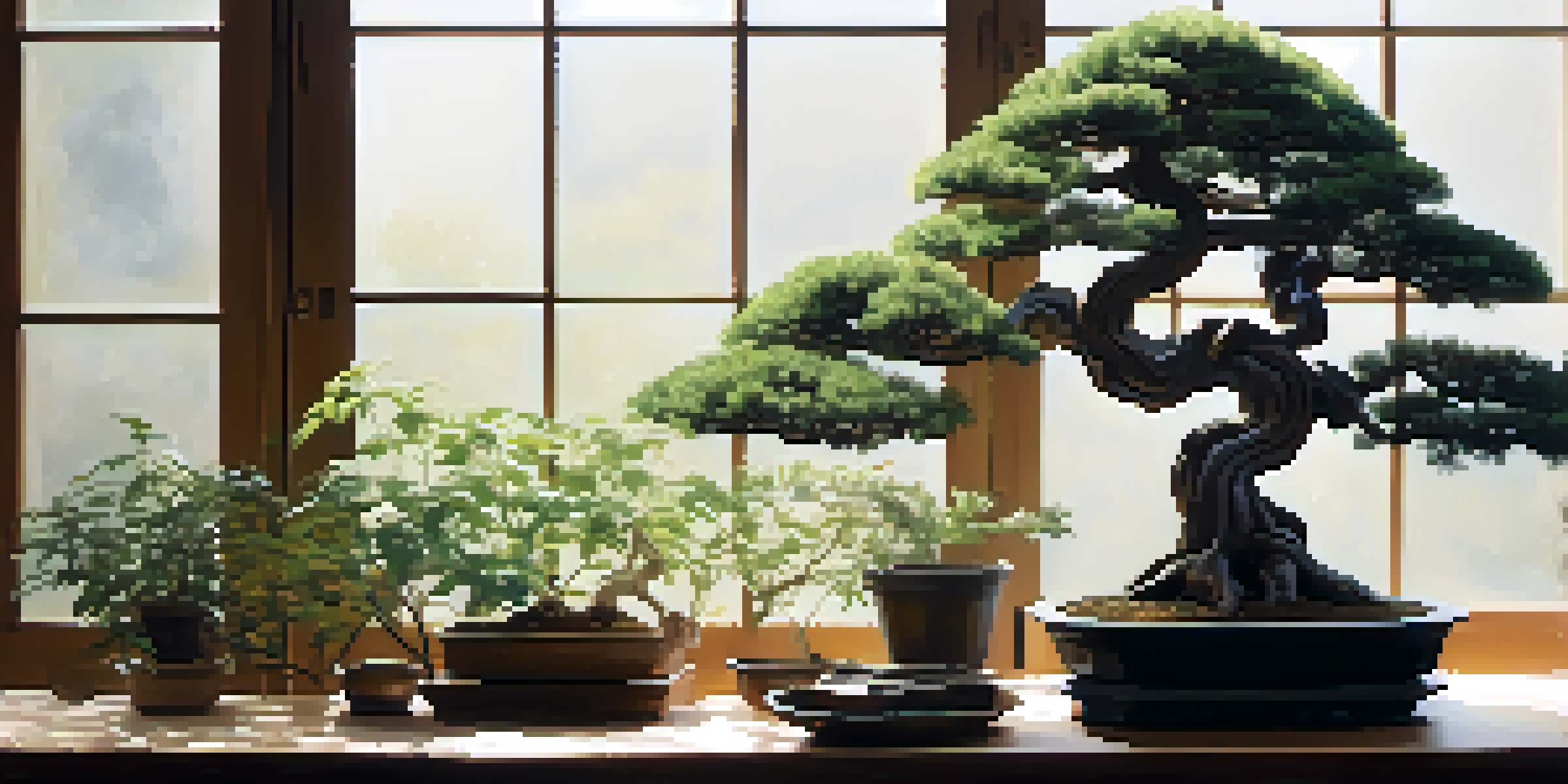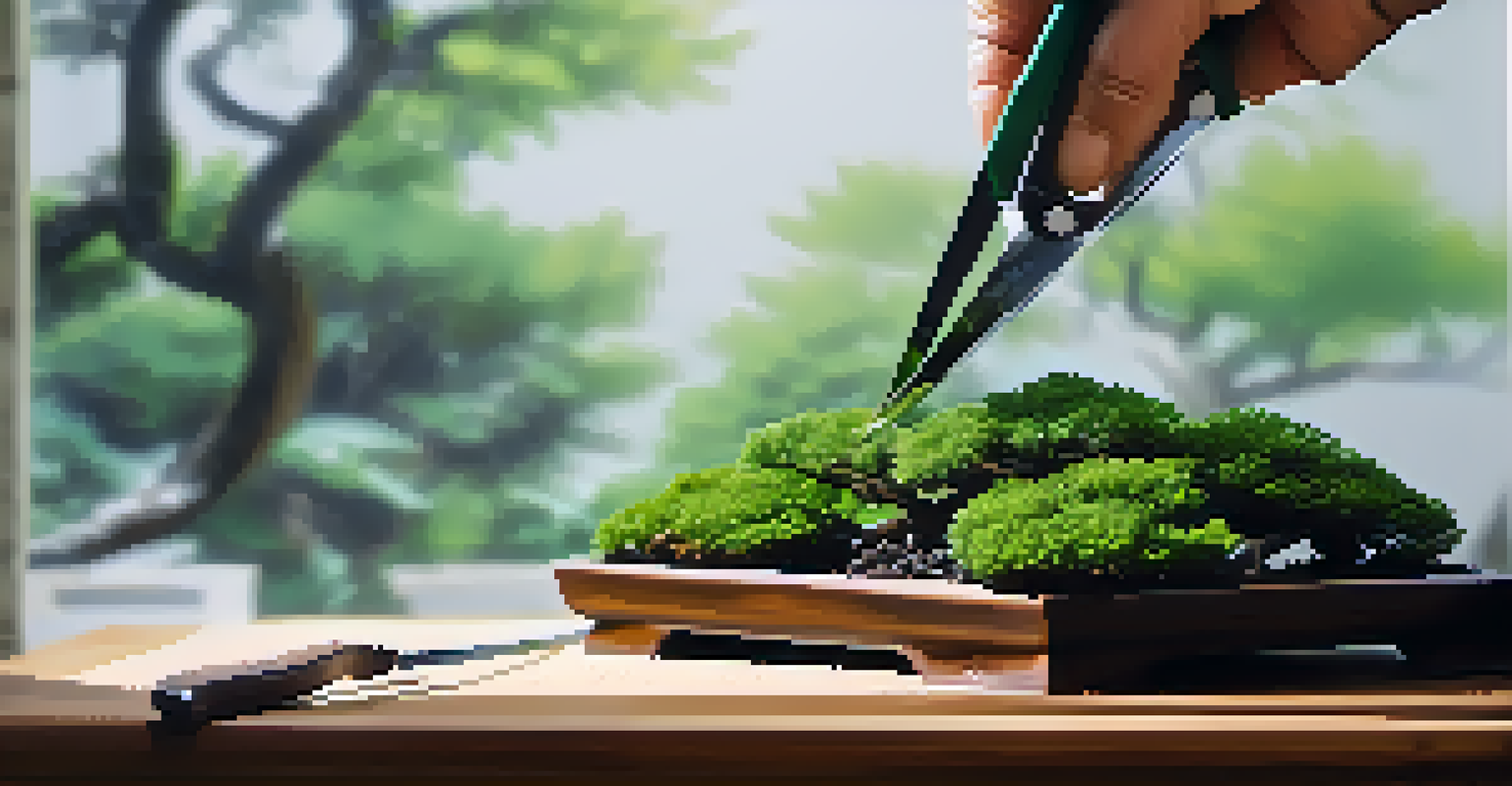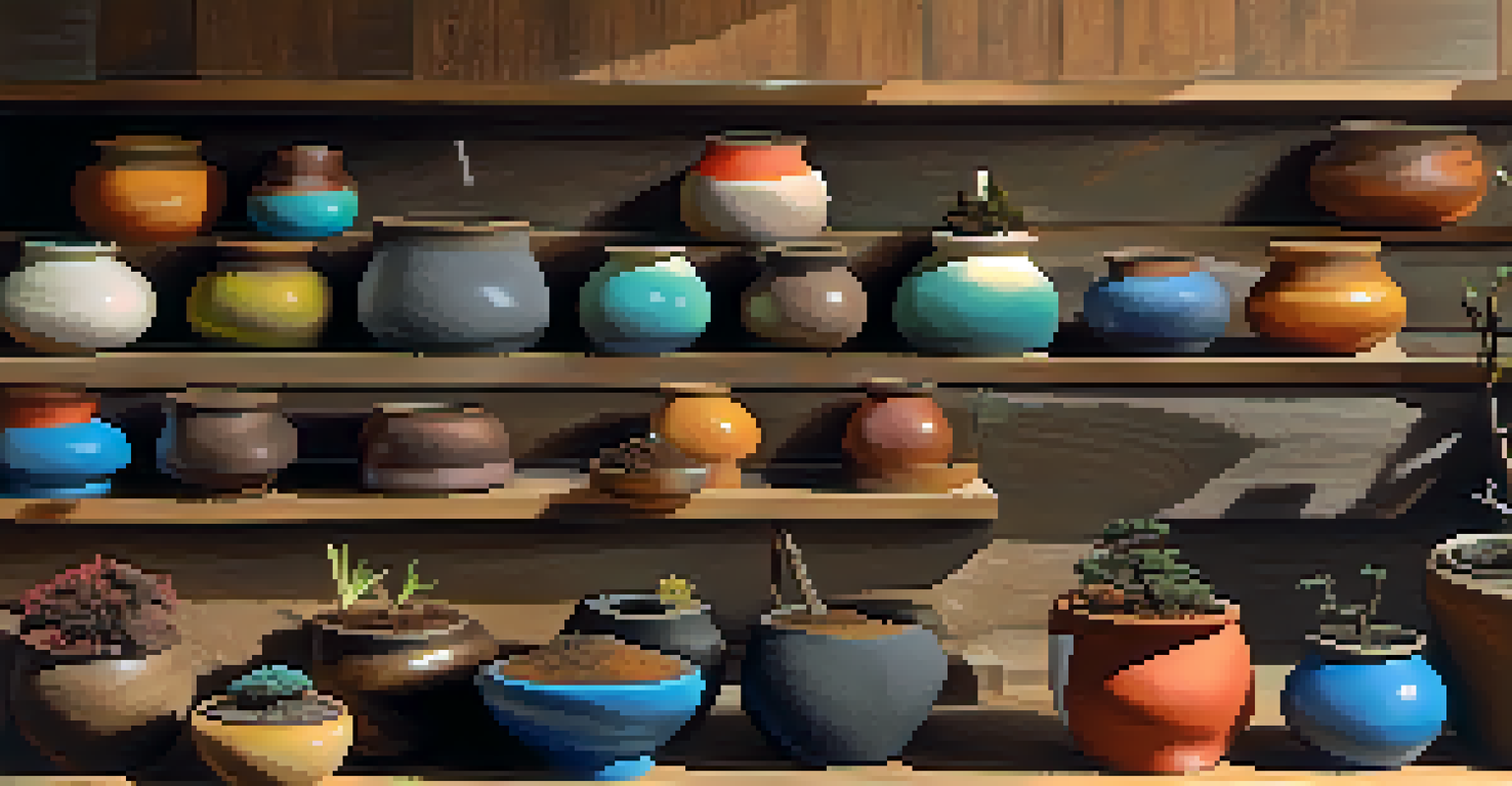Essential Tools for Successful Bonsai Cultivation

Understanding the Basics of Bonsai Cultivation Tools
Bonsai cultivation is an art that combines horticulture and aesthetics, requiring the right tools to achieve success. Just like a painter needs brushes, a bonsai enthusiast requires specific instruments to shape and nurture their trees. These tools not only simplify the cultivation process but also ensure that your bonsai thrives in a healthy environment.
The greatest gift of the garden is the restoration of the five senses.
Many beginners might think that any gardening tool will do, but each tool serves a unique purpose that contributes to the overall health of the bonsai. For instance, using the right type of scissors for pruning is vital to prevent damage to the delicate branches. Understanding the essential tools sets the foundation for a rewarding bonsai journey.
In the following sections, we'll explore various tools, their purposes, and how they can elevate your bonsai experience. By the end of this article, you'll have a comprehensive understanding of the tools you'll need to cultivate beautiful bonsai trees.
Bonsai Shears: The Heart of Pruning
Bonsai shears are perhaps the most iconic tool in a bonsai cultivator's toolkit. These sharp, specialized scissors are designed to make clean cuts on branches and leaves, promoting healthy growth. Unlike regular garden shears, bonsai shears allow for precision that helps maintain the tree's shape and encourages new growth.

When selecting bonsai shears, look for a pair that feels comfortable in your hand and has a sharp blade. It’s essential to keep them well-maintained, as dull blades can crush rather than cut, leading to potential harm to your tree. Regular sharpening and cleaning after use will extend the life of your shears and keep your bonsai healthy.
Essential Tools for Bonsai Care
Using the right tools, such as bonsai shears and specialized soil, is crucial for successfully cultivating healthy bonsai trees.
Remember, pruning is not just about cutting; it’s about shaping your bonsai and encouraging a specific aesthetic. With the right shears, you’ll find that pruning becomes a creative and enjoyable part of your bonsai care routine.
Wire for Shaping Your Bonsai
Wiring is a technique used to shape bonsai trees, allowing cultivators to guide their growth in desired directions. Aluminum and copper wires are the most commonly used, each offering different benefits. Aluminum wire is softer and easier to work with, making it a great choice for beginners, while copper wire provides a stronger hold for more advanced shaping.
To plant a garden is to believe in tomorrow.
When applying wire, it’s crucial to wrap it carefully around branches without damaging the bark. As the tree grows, the wire can dig into the bark if left on too long, leading to unsightly scars. Monitoring the wire and adjusting it as needed will help you achieve the perfect shape without harming your bonsai.
Wiring can be a meditative process, allowing you to connect with your tree and express your artistic vision. With practice, you’ll develop your own techniques and preferences, making it an integral part of your bonsai cultivation journey.
Soil and Potting Essentials for Bonsai Health
Soil is the lifeblood of any plant, and for bonsai, it’s crucial to use a mix that promotes drainage and aeration. Traditional garden soil is too dense for bonsai, which can lead to root rot. Instead, look for specific bonsai soil mixes that often include components like akadama, pumice, and lava rock, designed to keep the roots healthy and thriving.
Choosing the right pot is equally important; it should not only complement the aesthetic of your bonsai but also provide proper drainage. Pots with drainage holes allow excess water to escape, preventing root diseases. Additionally, the size of the pot should suit the growth stage of your tree, allowing enough space for roots to expand.
Proper Watering Techniques
Consistent and careful watering is vital to prevent root rot while ensuring your bonsai receives the moisture it needs.
Regularly refreshing the soil and repotting your bonsai every couple of years will help maintain its health. This process not only provides fresh nutrients but also gives you the opportunity to inspect the roots and trim any that may be damaged.
Watering Techniques for Your Bonsai Tree
Watering is a critical aspect of bonsai care, and understanding the right techniques can make all the difference. Bonsai trees require consistent moisture, but overwatering can lead to root rot. A good rule of thumb is to check the soil moisture regularly—when the top inch feels dry, it’s time to water.
Using a watering can with a fine spout allows for gentle watering, ensuring that you don’t disturb the soil or roots. It’s best to water until you see water drainage from the bottom of the pot, which indicates that the entire root system is adequately hydrated. Remember, each bonsai species may have different water needs, so keep an eye on your tree’s specific requirements.
Seasonal changes also affect watering frequency. During the growing season, your bonsai may need more frequent watering, while in the dormant winter months, you might reduce your watering schedule. Observing your bonsai’s response will guide you in developing a successful watering routine.
Fertilizers: Boosting Growth and Vitality
Fertilizing your bonsai is essential for providing the nutrients it needs to thrive. Bonsai trees benefit from a balanced fertilizer that contains nitrogen, phosphorus, and potassium, often referred to as NPK. These nutrients support healthy leaf and root development, ensuring your bonsai looks its best throughout the seasons.
Applying fertilizer during the growing season, typically spring and summer, will yield the best results. Liquid fertilizers can be diluted in water and applied every few weeks, while granular fertilizers can be mixed into the soil for a longer-lasting effect. Always follow the package instructions to avoid over-fertilization, which can harm your tree.
Pest Control Strategies
Regular inspections and natural treatments can effectively protect your bonsai from pests without harming the plant.
Keep in mind that different species may have unique nutritional needs, so it’s worth researching the specific requirements for the type of bonsai you’re cultivating. A little knowledge in this area can go a long way in ensuring your bonsai remains vibrant and healthy.
Pest Control: Protecting Your Bonsai
Pests can be a significant threat to the health of your bonsai, but with proactive measures, you can keep them at bay. Common pests like aphids, spider mites, and scale insects can damage your tree if left untreated. Regularly inspecting your bonsai for signs of infestation will help you catch any issues early on.
Using insecticidal soap or neem oil can be effective in managing pests without harming your tree. These treatments can be sprayed directly on affected areas, suffocating the insects while being gentle on the plant. Always test any treatment on a small section first to ensure your bonsai tolerates it well.

In addition to chemical treatments, promoting a healthy environment can deter pests naturally. Ensuring your bonsai has proper air circulation and avoiding overcrowding can go a long way in preventing infestations. With regular care and vigilance, you can keep your bonsai healthy and thriving.
Embracing the Bonsai Journey with the Right Tools
Cultivating bonsai is not just about the tools; it's about the journey of growth, patience, and creativity. Each tool plays a unique role in nurturing your bonsai, making the cultivation process both enjoyable and rewarding. By understanding and utilizing these essential tools, you can truly enhance your bonsai experience.
As you become familiar with the tools and techniques discussed in this article, you'll find that your connection with your bonsai deepens. You'll be able to shape it into a reflection of your artistic vision, whether that’s a traditional style or something entirely unique. The more you practice, the more confident you'll become.
Remember, bonsai cultivation is a lifelong journey filled with learning and growth. With the right tools in hand and a passion for nurturing your trees, you’ll create living art that brings joy for years to come.